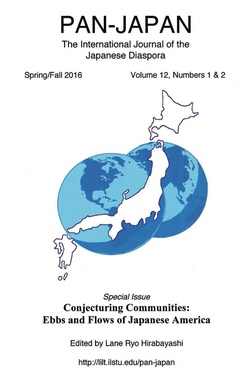
During my involvement in Japanese American studies, from 1972 to the present, I have been struck by two simultaneous developments. The first is a growing sophistication in theory and methodology among its academic practitioners; the second is a decreasing connection to and concern for the Japanese American community by these same scholars. While I do not see this bifurcated situation, which has been remarked on by many others in the field, as a “crisis” worthy of “alarmist” pronouncements, I do find it a cause for celebration to encounter the work of those academe-based teacher-scholars in Japanese American studies who, like Lane Ryo Hirabayashi, consistently produce and/or engender work that achieves a dynamic equilibrium between the competing demands of intellectual rigor and quality control and those of community enrichment and empowerment. It is precisely for this reason that I feel especially fortunate to review here the Hirabayashi-edited anthology, Conjecturing Communities: Ebbs and Flows of Japanese America, and also to highly recommend it for consumption to Nichi Bei Weekly readers.
The contents of this special issue of the Pan-Japan journal are easy to summarize. Bracketed by Hirabayashi’s exemplary introduction and judicious afterword, one is treated to seven pieces contributed, in consecutive order, by stellar community-based Japanese American studies scholars (Wesley Ueunten, Eri Kameyama, Kyung Hee Ha, Shigueru Tsuha, Amy Sueyoshi, Lily Anne Yumi Welty Tamai and James M. Ong). Six of these selections are substantive essays that focus, as per Hirabayashi, “on groups that may, or may very well not, become part of the larger Japanese American community in the twenty-first century” (Uchinanchu, or Okinawan Americans; Shin-Issei, or new post-war Japanese immigrants; Zainichi, or overseas Koreans born/raised in Japan, who are now living in the U.S.; Peruvian Japanese who now live in California; Japanese American members of lesbian, gay, bisexual, transgender, and queer populations; and immediate-post-war mixed race individuals who came to the U.S. as adoptees), while the seventh piece is an annotated bibliography that not only provides readers of the anthology with additional information on the history and experiences of the above noted six groups, but also showcases theoretical and analytic frameworks proposed to study their respective identity formation.
In his introduction, Hirabayashi informs us that he had field-tested the public performances of all of the contributors to Conjecturing Communities. He also allows as to how he encouraged them to “express their personal feelings” so that readers “can better understand what issues are important to you (and) . . . how you feel about those issues.” In reading Hirabayashi’s introductory essay, we are given proof that he had primed himself to put into practice what he had “preached” to his contributing authors. Indeed, although I have read a great deal of the exceedingly self-effacing Hirabayashi’s past writings, I found out in this venue alone more about his professional career trajectory and attendant development as an Asian American studies teacher and researcher than in virtually all of his combined antecedent scholarship.
While each of the six substantive essays abound with significant information based on diverse primary and secondary sources and take shape as polished, perceptive, and challenging interpretive studies, the two I found most infused with personal feelings were Wesley Ueunten’s “Okinawan Identity in the Diaspora: A Messy Genealogy” and Amy Sueyoshi’s “Why Queer Asian American Studies? Implications for Japanese America.” In the case of Ueunten, he asks rhetorically, “But why should I (as a Sansei . . . Okinawan born and raised in Hawaii with Nisei parents also born and raised in Hawaii) care about Okinawa?” To which he responds, “(Because) I have an undeniable emotional connection to Okinawa.” As for Sueyoshi, in discussing persisting homophobia in the progressive gay city of San Francisco, she writes: “I had a personal stake in this as well, because of my own Shin-Issei mother and her circle of Shin-Issei friends. Being queer around them is a funny mix of ‘we know — we like you — we don’t have to talk about it.’” I should add, however, that Shigueru Tsuha, in “Japanese Peruvians in California: Ethnic Identity Formations,” utilizes the introductory portion of his essay for autobiographically framing his otherwise standard community case study. Moreover, mention needs to be made here of how James M. Ong, in his superlative “‘Re-envisioning’ the Contours of the Japanese American Community of the Past and Present: An Annotated Bibliography of Sources and Texts which Expand the Scope of Inclusivity,” prefaces on multiple occasions his source recommendations with “I feel.”
If you want to get a handle on where the ever-changing Japanese American community is now heading, reading Conjecturing Communities is an invaluable starting point for such a journey of discovery.
PAN-JAPAN: The International Journal of the Japanese Diaspora: Special Issue: CONJECTURING COMMUNITIES: Ebbs and Flows of Japanese America
Edited by Lane Ryo Hirabayashi
(Normal, Ill.: Illinois State University, 2016, $12.50; Spring/Fall 2016: Volume 12, Numbers 1 & 2, 189 pp., paperback).
To purchase, write to: PAN-JAPAN (Vol. 12, No. 1 & 2), Subscriptions, Anthropology 4640, 332 Schroeder Hall, Illinois State University, Normal, Ill.
*This article was originally published by Nichi Bei Weekly on July 21, 2016.
© 2016 Arthur A. Hansen / Nichi Bei Weekly







